Digging Up Plugstreet Tuesday, July 28th, 2009
|
|
|
|
|
We have just been told that “Digging Up Plugstreet” by Richard Osgood and Martin Brown will be going to press this afternoon.
_
This account of our research to date is published by Haynes and is available through Amazon, as well as from all good bookshops.
_
Amazon.co.uk
_
Haynes
_
Rest assured that Martin and Richard will be rearranging the displays in bookshops to give themselves more prominence. I am assured it’s the perfect Christmas gift for the Great War obsessive in your household.
|
|
|
|
|
|
Filed under: A Dig Diary by
admin
Add a Comment »
|
|
Ave atque Vale Saturday, July 25th, 2009
|
|
|
|
|
With the death of Harry Patch it seems that the last living link to the trenches has gone. Harry knew the world we are excavating and reconstructing through our work. To him the trenches were newly built, the tins weren’t rusty and all those names on the memorials were real, living, young people.
_
How appropriate that the man whose passing marks this moment of shift should be one who did not want to fight but was conscripted and who held off killing for as long as possible.
_
Harry Patch, plumber, fireman, gentleman and soldier.
|
|
|
|
|
|
Filed under: Great War History by
admin
1 Comment »
|
|
Standing To! Wednesday, July 15th, 2009
|
|
|
|
|
It’s that time of year again.
_
We will be on site from Friday 31 to Thursday 6th August at St Yvon.
_
The main team will be looking for further evidence of the Australian fortification of the mine crater and of ground held following the Messines attack. In addition we hope to investigate the entrance to a German concrete shelter to see something of the architecture and stratigraphy of the access to it from the trench.
_
While the main thrust of fieldwork will concentrate on the 33 Bn objectives from 7th June 1917, The Colonel will be leading a recce party to look at Hill 63 and carry out geophysical survey that we hope will inform work in coming years.
_
As ever we will be joined by our Belgian friends, including members of the Comines-Warneton Historical Society.
_
Not all the regulars will be with us in Belgium, we’ll be missing James, Chass, Lesley, Birger and Jon, but we do say “Congratulations!” to Sylvia who isn’t coming out on the paltry excuse that she is getting married!
_
We hope to be continuing with the blog while we are away. Watch this space.
|
|
|
|
|
|
Filed under: A Dig Diary by
admin
Add a Comment »
|
|
Updates Monday, June 22nd, 2009
|
|
|
|
|
The dates for the August season at Ploegsteert have been announced and the likely team members alerted. It’s nice to be looking forward to another week in the field.
_
Meanwhile our friends from GWAG and our own Rod have been busy looking for the traces of WW2 anti-invasion defences and WW1 anti-aircraft defences at Shooters Hill, near Woolwich in London. You can see what they’ve been up to here:
_
http://diggingdadsarmy.blogspot.com
_
And finally…
Richard and Martin hosted a Bristol University Masters group for a week of excavation on part of the Bustard practice trench system. While one area opened gave inconclusive results, apart from as a rubbish dump, the other revealed a beautifully dug, deep trench cut into the chalk.
|
|
|
|
|
|
Filed under: A Dig Diary by
admin
Add a Comment »
|
|
Lost in Flanders Wednesday, April 22nd, 2009
|
|
|
|
|
Anzac Day is almost upon us – April 25th. Some my recall the filming of the first season of excavation back in 2007 – well this will form part of a documentary, ‘Lost in Flanders’, that is being aired in Australia tomorrow. A link to a site with a promo of the programme is here:
www.screenaustralia.gov.au/showcases/lostinflanders
_
Along with Jo, Becks, Martin (and perhaps others?!) the film will include two members of the team from 2007 – Mat and Michael.
_
Left: Mat, right: Michael
_
|
|
|
|
|
|
Filed under: A Dig Diary by
admin
Add a Comment »
|
|
What they carried Sunday, March 29th, 2009
|
|
|
|
|
The first object photos
_
Amongst other grenades and fragments was this tin for rifle grenade fuses, found in the British fire trench
_
Given the NML recovery of the remains of the Australian soldier in 2008, the find of this shoulder title as part of the topsoil machining was especially poignant.
|
|
|
|
|
|
Filed under: Uncategorized by
admin
Add a Comment »
|
|
The Value of Archaeology Saturday, March 28th, 2009
|
|
|
|
|
Some time to reflect later..
_
An amazing amount was packed into the No-Man’s-Land rescue work at St Yvon. Survey using GPR (radar) and other geophysical techniques were excellent in locating some of the mine shafts in the region – excellent news for the overall project research.
_
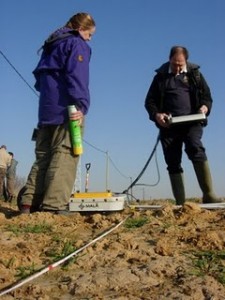
Radar in Operation with Peter and Becs
_
The top of the bunker we found was viewed in full by the farmer who thinks he will only need to move a small part of it to prevent damage to his plough and there should be no risk of damage to the British trenches. The true value of archaeological research was thus shown.
_
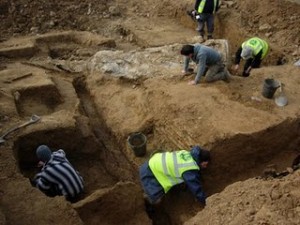
Working on the trenches, bunker and trench boards
_
As mentioned earlier – many finds. From butterscotch tins, pipe stems and mirrors to medicine bottles and an Australian shoulder title and (?) Fusilier shoulder title.
_
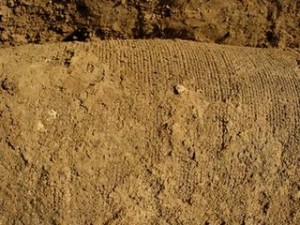
A sandbag filled with concrete and still showing the original weft
_
We always work with the highest standard of bomb cover, essential both in dealing with live ammunition and also in identifying some of the other elements of spent ordnance we uncover. Cheers to Rod and Gontrand once again!
_

Justin and Gontrand at work
_
|
|
|
|
|
|
Filed under: A Dig Diary by
admin
Add a Comment »
|
|
Beneath Flanders (or Wallonian) fields Tuesday, March 24th, 2009
|
|
|
|
|
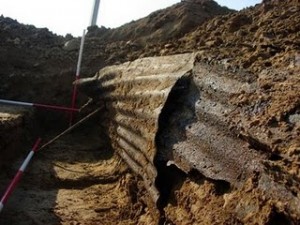
The Traverse in the British trench, St Yvon 2009
_
The team is now back from an enormously successful piece of rescue archaeology at St Yvon. For three days we recorded the remnants of a bunker that lay on the front of the British line. In association with this concrete structure was the multi-phase British fire trench, initially with brick footings and then with trench boards, corrugated iron revetting and A-frames. _
_
A concrete-filled sandbag also survived. As one would expect, the trench had hundreds of spent .303 rounds, along with rum jar and more personal items such as a pipe, mirror and some printed material; perhaps part of a racy magazine story at first glance! Much more to follow…
_
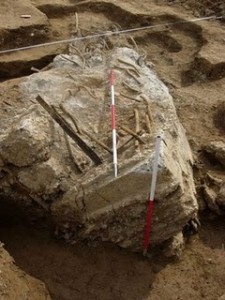
Remnants of the Bunker
_
Thanks to the Comines-Warneton history Society, Mnr Delrue, Messines Peace Village and (of course) Claude and Nelly at L’Auberge in Ploegsteert. the weather was fine, the beer good and the team excellent. Hurrah!
|
|
|
|
|
|
Filed under: A Dig Diary by
admin
1 Comment »
|
|
Ground Penetrating Radar Wednesday, March 18th, 2009
|
|
|
|
|
The Project team want to say a very big thanks to Geomatrix and to their owner Chris Leech.
_
The company (Geomatrix Earth Science Ltd) offers one of the largest hire pools of near surface geophysical instrumentation in Europe. They are exclusive sales representatives for many of the leading geophysical instrument and software manufacturers. Their instruments are world renowned for their emphasis on providing high data quality and instrument reliability in the most arduous of field conditions (which now includes former battlefields).
_
Geomatrix are loaning us GPR (Ground Penetrating Radar) equipment to help us survey the British line, and to have a look at Jon’s German position, that we started to excavate last year.
_
We welcome Geomatrix as the first Corporate Sponsor of the Plugstreet Project and welcome their contribution to our on-going research into both the battlefield itself and into the use of geophysics on this sort of site.
_
We hope to be able to post results of the survey soon, so you can see their amazing kit in action.
www.geomatrix.co.uk
|
|
|
|
|
|
Filed under: A Dig Diary by
admin
Add a Comment »
|
|
Back Into The Line Sunday, March 15th, 2009
|
|
|
|
|
On Friday a small party of us will be going out to Belgium.
_
Last year during ploughing the tenant discovered the remains of a British concrete bunker. Unsurprisingly he wasn’t happy about a bent plough and a load of rubble in the potato field so plans to remove it. Fortunately the landowner told us that this will happen and has given us the opportunity to undertake rescue recording of the bunker and do a limited amount of excavation around it in the British Line.
_
Previously we have never had opportunity to look at the British trenches so this is both exciting and very useful for our research into the development of the battlefield.
_
As usual we will be staying with our friends at the Peace Village in Messines and enjoying the excellent food of Claude at The Auberge at Plugstreet – www.auberge-ploegsteert.be
_
We hope to be updating the blog during our stay.
|
|
|
|
|
|
Filed under: A Dig Diary by
admin
1 Comment »
|
|
|
|
|
|